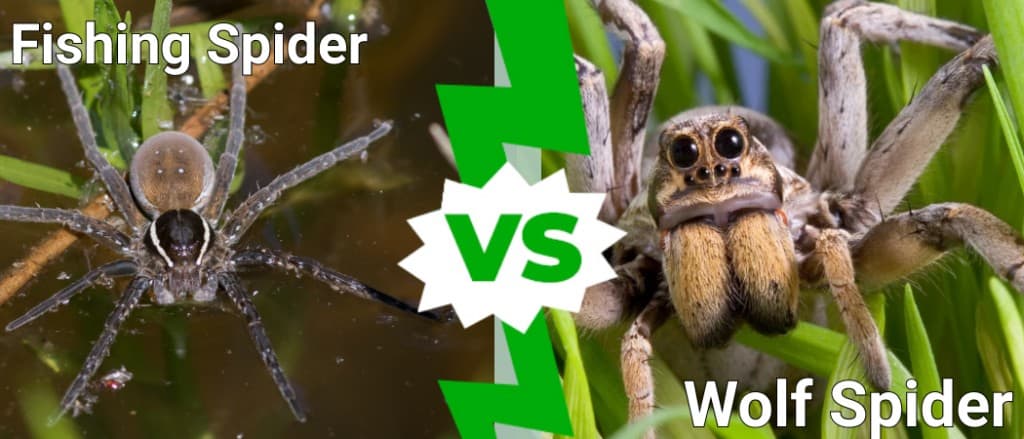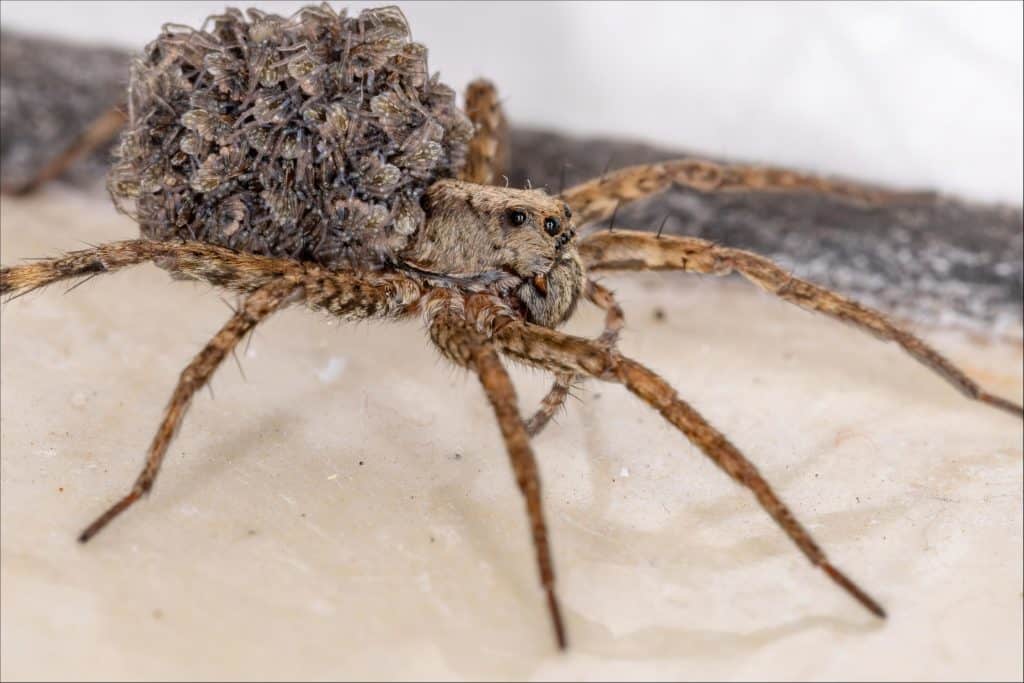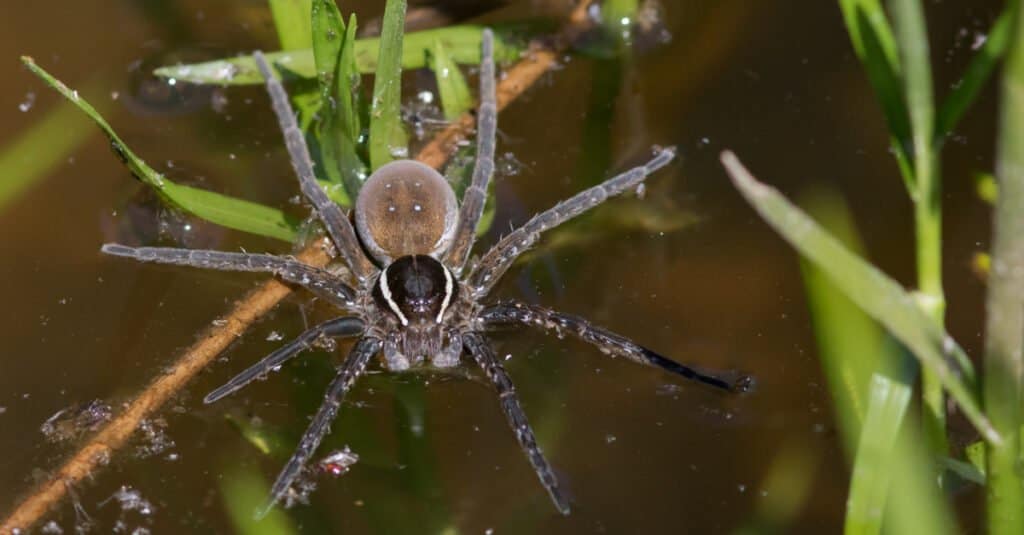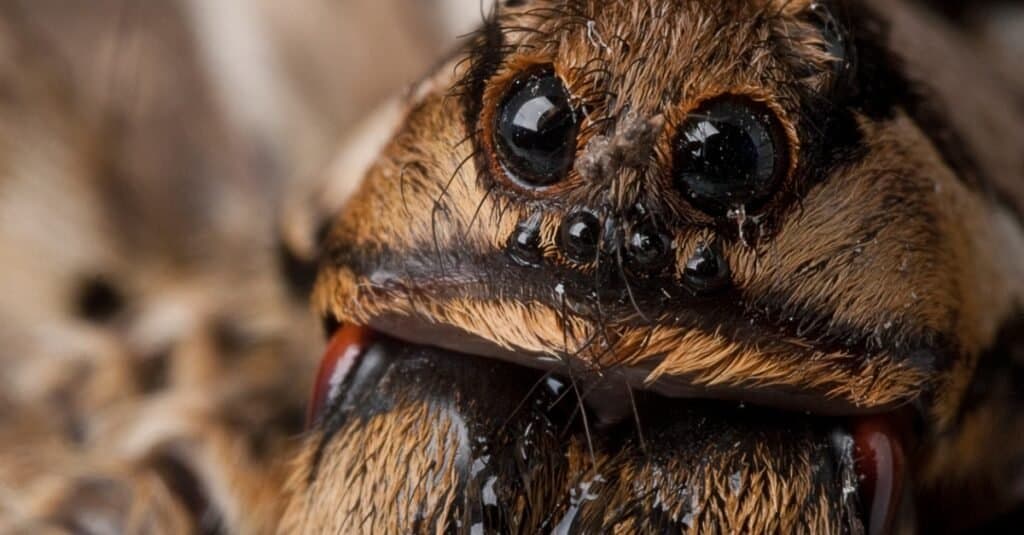Key Points:
- Wolf spiders’ eyes tend to be larger compared to that of fishing spiders, resulting in excellent vision for the former.
- Wolf spiders are more likely to be found close to insects’ burrows or nests while fishing spiders are more likely to be found close to ponds.
- Fishing spiders’ legs are long and suited for walking on water; wolf spiders’ legs are short, powerful, and stocky and suited for sprinting after prey.
Fishing spiders and wolf spiders have a lot of similarities. Most people that see one will often confuse it for the other. Of course, many people will assume the worst case, that it’s a wolf spider, despite those creatures not being particularly harmful to human beings. Still, if you have to tell these two creatures apart, then you need to know the differences between a fishing spider vs wolf spider.
We have compiled a list of the significant differences between these two spiders. You’ll learn how to tell these spiders apart with a glance. That way, you’ll know what kind of spider has welcomed itself into your home or is currently residing in an outbuilding on your property!
Comparing a Fishing Spider and a Wolf Spider

The 6 Key Differences Between Fishing Spiders and Wolf Spiders

A
wolf spider
will often carry its young on its back.
©Vinicius R. Souza/Shutterstock.com
The biggest differences between a fishing spider and a wolf spider are their colors, leg length, and eyes even though most people probably don’t want to get too close to their faces to see their eyes at first.
Although fishing spiders and wolf spiders can be brown and gray with banded leg colors, wolf spiders will often have a thick distinct stripe running down its body. That stripe can be a lighter color than the rest of the wolf spider, or it can be darker. The same is not found on a fishing spider.
Fishing spiders have longer legs than wolf spiders because of their need to walk on water. Lastly, fishing spiders have eight eyes in two horizontal rows with four eyes in each, but wolf spiders have eight eyes in three rows, with two eyes, then two larger eyes, then four small eyes. Wolf spiders’ eyes are very large compared with other spiders and helps them have great vision.
These key differences can help you identify the spiders quickly and easily.
Size
The wolf spider can grow larger than the average fishing spider. Granted, the Dolomedes (fishing spider family) can vary in length, they average about 0.35 inches to 1 inch in body length without the addition of its leg length. Wolf spiders measure between 0.25 inches to 1.2 inch for their body length
When you factor in the leg length, fishing spiders are about the same size or longer than wolf spiders.
Location

Some wolf spiders dig burrows. They hide in the burrow, and when an insect walks by, they pounce
©iStock.com/martinezcanovas
Fishing spiders are found near water sources such as streams and ponds. Wolf spiders are most often found in dark recesses such as tree hollows or at the entry area of insect burrows where they can easily feed.
Both spiders sometimes become trapped indoors when they chase prey into a house, but it’s more likely that a wolf spider moves indoors and hunts in basements and other dark areas.
Hunting Methods

Fishing spiders live near aquatic areas and hunt prey around the water.
©Frode Jacobsen/Shutterstock.com
The fishing spider hunts by using the hairs on its legs to detect prey, but wolf spiders use their eyes to find prey and their powerful legs to chase them down. Both creatures have trichobothria, the fine hairs on their legs that sense the world around them, but fishing spiders use them as their primary means of finding prey.
Colors

This
wolf spider
has a stripe on its body but no banding on its legs.
©iStock.com/Michele Jackson
Fishing spiders will often be brown and gray with banded patterns on their legs. Wolf spiders are usually light brown, dark brown, gray, or tan, and they frequently have a stripe running down their backs in a lighter or darker color. Wolf spiders may also have additional patterns on its body and legs.
Leg Length
The fishing spider has long legs that are used to walk on water using surface tension. Wolf spiders have short, stocky, and powerful legs that help them run down their prey.
Eyes

Wolf spiders’ eyes are in three horizontal rows on the center of their heads.
©iStock.com/JAH
All fishing spiders and wolf spiders have eight eyes, but they are arranged differently. Fishing spiders have eight eyes spread across two rows, four on top and four on the bottom.
Wolf spiders’ eyes are arranged in three horizontal rows and centered on the head. They contain two small eyes, two large eyes, and then another four eyes on the bottom. Wolf spiders’ eyes are very visible to humans since they are the primary means that wolf spiders use to identify their prey.
Fishing spiders and wolf spiders look somewhat alike, but you can tell them apart by learning their most obvious differences. In this case, look at the spiders’ size, location, colors, and leg length. These factors are the easiest and safest way to tell the two creatures apart.
Remember that neither the fishing spider nor the wolf spider wishes to be in your home most of the time. A wolf spider might have wandered into your home in search of food and then become trapped.
They’re excellent at killing pests for the short time they’ll stay in your home, and they pose a very small threat to humans since they would prefer to avoid being seen by humans at all. Instead of killing them, it’s a good idea to leave these spiders alone unless you have small children or pets that they could harm.
Bonus: What Keeps Spiders Away?

Tea tree oil is an excellent alternative to commercial pesticides, as the scent repels spiders.
©AmyLv/Shutterstock.com
While wolf spiders and fishing spiders are technically harmless to humans, you may not like the idea of spiders in your home of any kind–especially the venomous variety! The best way to keep poisonous spiders out of your home is to try and prevent them from entering in the first place. As spiders can get into your home through holes and cracks, you can check for possible entryways with a flashlight. If the light gets through from the inside to the outside, you should fill that hole or crevice with an appropriate product.
Keeping your yard free of debris and overgrown vegetation helps cut down on areas spiders would gravitate to. Caulking doors and windows is also a good strategy to keep them out.
Spiders hate certain scents, so scented essential oils can help deter them like peppermint, tea-tree, lavender, and rose. You can add 15-20 drops of a particular oil in a water bottle mixed with water and spritz it around your house. They also hate the smell of cinnamon and vinegar so these scents can be used similarly.
Rubbing lemon or orange peels on the baseboards along your walls, on window sills, and on other surfaces can also repel spiders, who dislike citrus smells. Furniture polish and cleaning products with lemon scent can also help.
Regular cleaning inside your home, especially in areas that are dark or less frequented, is necessary to keep spiders from setting up residence. It’s also important to keep an eye on fruit bowls, as they can attract spiders.
The photo featured at the top of this post is © Cornel Constantin/Shutterstock.com
Thank you for reading! Have some feedback for us? Contact the AZ Animals editorial team.






